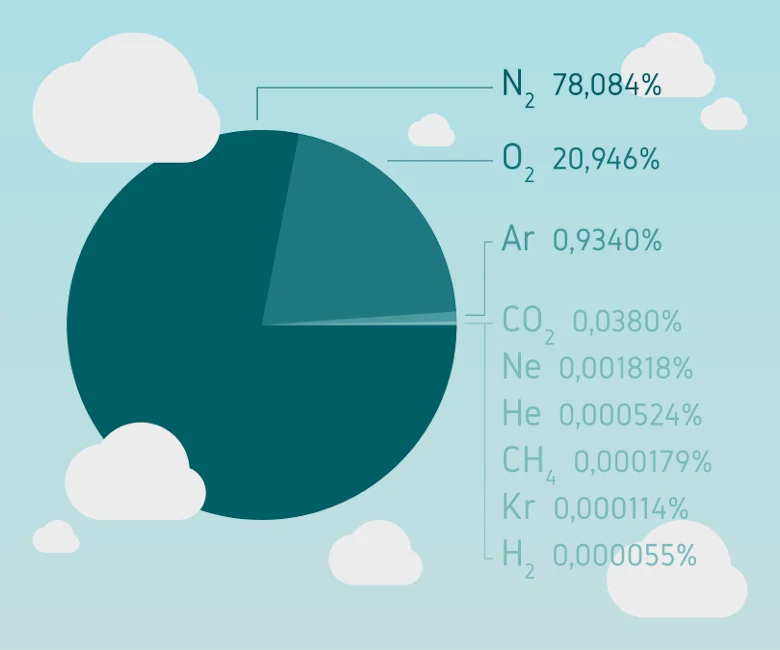Composition of air: Answers to all frequently asked questions

This article aims to answer some of the most frequently asked questions about the composition of air. It will provide an overview of what compounds makeup air and how they interact with each other. We will also take a closer look at the chemical composition of air and examine how different elements contribute to its makeup. Finally, we’ll explore why understanding the building blocks of air is important for both environmental health and human well-being. With this comprehensive guide, you’ll have all the information you need to understand more about the atmosphere that sustains us every day!
What Is Composition Of Air?
Air is a mixture of gases that surrounds the Earth. The composition of air is mostly nitrogen and oxygen, with smaller amounts of other gases.
Nitrogen makes up about 78% of the air, while oxygen makes up about 21%. The remaining 1% is made up of other gases, like carbon dioxide, argon, neon, helium, methane, krypton, etc. This pie chart shows a detailed breakdown of the composition of air.

Carbon dioxide is a gas that is important for plants to grow, but too much of it in the air can cause problems like climate change. Argon, neon, helium, methane, and krypton are all present in very small amounts in the air, but they still play important roles in the atmosphere.
Air also contains tiny particles called aerosols, which can come from natural sources like dust and wildfires, or human activities like burning fossil fuels. These aerosols can have important effects on air quality and climate.
Overall, the composition of air is an important aspect of the Earth's environment and is crucial to life on our planet.
What Are The 5 Components Of Air?
There are five main components of air, including:
- Nitrogen \(\mathrm{(N_2)}\): Nitrogen is an essential element for all living things and is also used in many industrial processes.
- Oxygen \(\mathrm{(O_2)}\): Oxygen is the gas that our bodies use to breathe, and without it, we would not be able to survive.
- Argon \(\mathrm{(Ar)}\): Argon is an inert gas, which means that it does not react with other substances.
- Carbon dioxide \(\mathrm{(CO_2)}\): Carbon dioxide is an important component of the Earth's atmosphere because it helps to regulate the Earth's temperature.
- Trace gases: The remaining components of air are made up of trace gases, which include neon, helium, methane, krypton, hydrogen, and xenon. These gases make up only a small fraction of the air we breathe, but they are still important for understanding the Earth's atmosphere.
Overall, the combination of these five components makes up the air we breathe, and each of them plays an essential role in the Earth's atmosphere and the processes that occur within it.
What Is The Composition Of Each Gas In The Air?
| Gas | Chemical Symbol | Percentage in Air |
|---|---|---|
| Nitrogen | \(\mathrm{N_2}\) | \(78.08\%\) |
| Oxygen | \(\mathrm{O_2}\) | \(20.95\%\) |
| Argon | \(\mathrm{Ar}\) | \(0.93\%\) |
| Carbon Dioxide | \(\mathrm{CO_2}\) | \(0.04\%\) |
| Neon | \(\mathrm{Ne}\) | \(0.0018\%\) |
| Helium | \(\mathrm{He}\) | \(0.0005\%\) |
| Methane | \(\mathrm{CH_4}\) | \(0.0002\%\) |
| Krypton | \(\mathrm{Kr}\) | \(0.0001\%\) |
| Hydrogen | \(\mathrm{H_2}\) | \(0.00005\%\) |
How do components of air interact with each other?
The most abundant gas in the air is nitrogen, which makes up about 78% of the air we breathe. Oxygen is the second most abundant gas, making up about 21% of the air. These two gases do not react with each other, which means that they do not combine to form a new substance. Instead, they simply mix together to form the air that we breathe.
Carbon dioxide, on the other hand, is a gas that can interact with other gases in the air. For example, plants use carbon dioxide to make their food through a process called photosynthesis. During this process, carbon dioxide combines with water and sunlight to create glucose and oxygen. This means that carbon dioxide is constantly being removed from the air by plants.
Another way that gases in the air interact with each other is through the process of diffusion. Diffusion is the movement of molecules from an area of high concentration to an area of low concentration. In the case of the air, this means that gases will naturally mix with each other until they are evenly distributed throughout the space.
Overall, the components of air interact with each other in many different ways, including through diffusion and chemical reactions like photosynthesis. These interactions help to maintain the balance of gases in the air, which is important for the health of the planet and all living things that depend on it.
Why there is 78% nitrogen in the atmosphere?
The reason why nitrogen is so abundant in the air has to do with the way our planet was formed. When the Earth was first formed, it was covered in hot magma, or molten rock. As the planet cooled, the gases that were present in the atmosphere began to condense and form the air we breathe today.
Nitrogen, being a very stable gas, was able to remain in the atmosphere as the planet cooled. Other gases, like hydrogen and helium, were not as stable and escaped into space. This is why there is very little hydrogen and helium in the Earth's atmosphere today.
Another reason why nitrogen is so abundant in the air is because it is not used up by living things in the same way that oxygen is. Plants and animals need oxygen to breathe, but they do not need nitrogen in the same way. It is due to all of these factors that there's 78% nitrogen in the air.
Why do humans not breathe nitrogen?
Humans do not breathe nitrogen because our bodies are not able to use nitrogen as a source of energy or to sustain life.
In fact, breathing in nitrogen can be dangerous or even deadly, as it can lead to a condition called nitrogen narcosis. This condition occurs when a person inadvertently inhales excessive nitrogen during deep-sea diving. A person who suffers from this condition can feel symptoms such as confusion, dizziness, and impaired judgment.
Why understanding the building blocks of air is important for both environmental health and human well-being?
Understanding the building blocks of air is crucial for both environmental health and human well-being. Air is made up of several gases, including nitrogen, oxygen, carbon dioxide, and trace amounts of other gases. These gases are essential for life on Earth, but they can also have harmful effects on human health and the environment when they are not in the right balance.
For example, nitrogen and oxygen make up the majority of the air we breathe, and they are both essential for life. Nitrogen is an important component of proteins and nucleic acids, while oxygen is needed for cellular respiration. However, too much nitrogen can lead to problems like eutrophication, which can harm aquatic ecosystems. Too much carbon dioxide in the atmosphere can also lead to climate change, which has significant impacts on human health and the environment.
Understanding the building blocks of air can help us to monitor and control these gases to ensure that they are in the right balance. For example, measuring the levels of nitrogen and carbon dioxide in the air can help us to identify areas where there are environmental problems and take action to address them. This can include things like reducing emissions from vehicles and industrial processes, planting trees to absorb carbon dioxide, and improving wastewater treatment to reduce nitrogen levels.
In addition to the environmental benefits, understanding the building blocks of air is also important for human health. Air pollution can have serious health effects, including respiratory problems, heart disease, and cancer. By understanding the sources of air pollution and how it affects human health, we can take steps to reduce our exposure and protect ourselves and our communities.
If you liked this article, check out our blog on Atmosphere And Environment next.
 SG
SG  VN
VN 












